Wenbo Wang
LLM Enabled Multi-Agent System for 6G Networks: Framework and Method of Dual-Loop Edge-Terminal Collaboration
Sep 05, 2025Abstract:The ubiquitous computing resources in 6G networks provide ideal environments for the fusion of large language models (LLMs) and intelligent services through the agent framework. With auxiliary modules and planning cores, LLM-enabled agents can autonomously plan and take actions to deal with diverse environment semantics and user intentions. However, the limited resources of individual network devices significantly hinder the efficient operation of LLM-enabled agents with complex tool calls, highlighting the urgent need for efficient multi-level device collaborations. To this end, the framework and method of the LLM-enabled multi-agent system with dual-loop terminal-edge collaborations are proposed in 6G networks. Firstly, the outer loop consists of the iterative collaborations between the global agent and multiple sub-agents deployed on edge servers and terminals, where the planning capability is enhanced through task decomposition and parallel sub-task distribution. Secondly, the inner loop utilizes sub-agents with dedicated roles to circularly reason, execute, and replan the sub-task, and the parallel tool calling generation with offloading strategies is incorporated to improve efficiency. The improved task planning capability and task execution efficiency are validated through the conducted case study in 6G-supported urban safety governance. Finally, the open challenges and future directions are thoroughly analyzed in 6G networks, accelerating the advent of the 6G era.
Denoising, segmentation and volumetric rendering of optical coherence tomography angiography (OCTA) image using deep learning techniques: a review
Feb 20, 2025Abstract:Optical coherence tomography angiography (OCTA) is a non-invasive imaging technique widely used to study vascular structures and micro-circulation dynamics in the retina and choroid. OCTA has been widely used in clinics for diagnosing ocular disease and monitoring its progression, because OCTA is safer and faster than dye-based angiography while retaining the ability to characterize micro-scale structures. However, OCTA data contains many inherent noises from the devices and acquisition protocols and suffers from various types of artifacts, which impairs diagnostic accuracy and repeatability. Deep learning (DL) based imaging analysis models are able to automatically detect and remove artifacts and noises, and enhance the quality of image data. It is also a powerful tool for segmentation and identification of normal and pathological structures in the images. Thus, the value of OCTA imaging can be significantly enhanced by the DL-based approaches for interpreting and performing measurements and predictions on the OCTA data. In this study, we reviewed literature on the DL models for OCTA images in the latest five years. In particular, we focused on discussing the current problems in the OCTA data and the corresponding design principles of the DL models. We also reviewed the state-of-art DL models for 3D volumetric reconstruction of the vascular networks and pathological structures such as the edema and distorted optic disc. In addition, the publicly available dataset of OCTA images are summarized at the end of this review. Overall, this review can provide valuable insights for engineers to develop novel DL models by utilizing the characteristics of OCTA signals and images. The pros and cons of each DL methods and their applications discussed in this review can be helpful to assist technicians and clinicians to use proper DL models for fundamental research and disease screening.
Graph-Enhanced Dual-Stream Feature Fusion with Pre-Trained Model for Acoustic Traffic Monitoring
Dec 26, 2024



Abstract:Microphone array techniques are widely used in sound source localization and smart city acoustic-based traffic monitoring, but these applications face significant challenges due to the scarcity of labeled real-world traffic audio data and the complexity and diversity of application scenarios. The DCASE Challenge's Task 10 focuses on using multi-channel audio signals to count vehicles (cars or commercial vehicles) and identify their directions (left-to-right or vice versa). In this paper, we propose a graph-enhanced dual-stream feature fusion network (GEDF-Net) for acoustic traffic monitoring, which simultaneously considers vehicle type and direction to improve detection. We propose a graph-enhanced dual-stream feature fusion strategy which consists of a vehicle type feature extraction (VTFE) branch, a vehicle direction feature extraction (VDFE) branch, and a frame-level feature fusion module to combine the type and direction feature for enhanced performance. A pre-trained model (PANNs) is used in the VTFE branch to mitigate data scarcity and enhance the type features, followed by a graph attention mechanism to exploit temporal relationships and highlight important audio events within these features. The frame-level fusion of direction and type features enables fine-grained feature representation, resulting in better detection performance. Experiments demonstrate the effectiveness of our proposed method. GEDF-Net is our submission that achieved 1st place in the DCASE 2024 Challenge Task 10.
UniGraspTransformer: Simplified Policy Distillation for Scalable Dexterous Robotic Grasping
Dec 03, 2024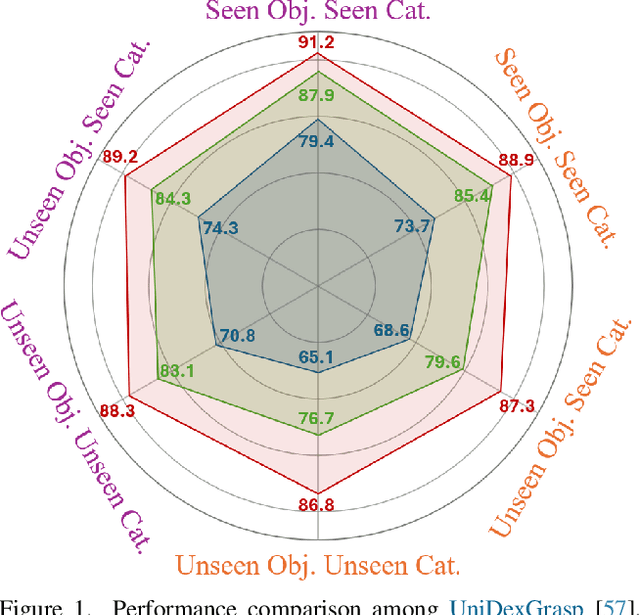

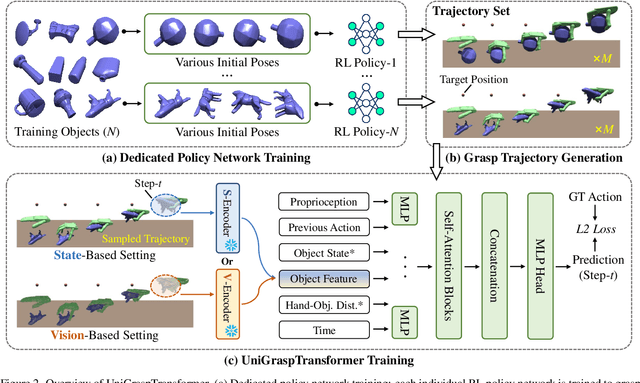

Abstract:We introduce UniGraspTransformer, a universal Transformer-based network for dexterous robotic grasping that simplifies training while enhancing scalability and performance. Unlike prior methods such as UniDexGrasp++, which require complex, multi-step training pipelines, UniGraspTransformer follows a streamlined process: first, dedicated policy networks are trained for individual objects using reinforcement learning to generate successful grasp trajectories; then, these trajectories are distilled into a single, universal network. Our approach enables UniGraspTransformer to scale effectively, incorporating up to 12 self-attention blocks for handling thousands of objects with diverse poses. Additionally, it generalizes well to both idealized and real-world inputs, evaluated in state-based and vision-based settings. Notably, UniGraspTransformer generates a broader range of grasping poses for objects in various shapes and orientations, resulting in more diverse grasp strategies. Experimental results demonstrate significant improvements over state-of-the-art, UniDexGrasp++, across various object categories, achieving success rate gains of 3.5%, 7.7%, and 10.1% on seen objects, unseen objects within seen categories, and completely unseen objects, respectively, in the vision-based setting. Project page: https://dexhand.github.io/UniGraspTransformer.
Independent Feature Enhanced Crossmodal Fusion for Match-Mismatch Classification of Speech Stimulus and EEG Response
Oct 19, 2024



Abstract:It is crucial for auditory attention decoding to classify matched and mismatched speech stimuli with corresponding EEG responses by exploring their relationship. However, existing methods often adopt two independent networks to encode speech stimulus and EEG response, which neglect the relationship between these signals from the two modalities. In this paper, we propose an independent feature enhanced crossmodal fusion model (IFE-CF) for match-mismatch classification, which leverages the fusion feature of the speech stimulus and the EEG response to achieve auditory EEG decoding. Specifically, our IFE-CF contains a crossmodal encoder to encode the speech stimulus and the EEG response with a two-branch structure connected via crossmodal attention mechanism in the encoding process, a multi-channel fusion module to fuse features of two modalities by aggregating the interaction feature obtained from the crossmodal encoder and the independent feature obtained from the speech stimulus and EEG response, and a predictor to give the matching result. In addition, the causal mask is introduced to consider the time delay of the speech-EEG pair in the crossmodal encoder, which further enhances the feature representation for match-mismatch classification. Experiments demonstrate our method's effectiveness with better classification accuracy, as compared with the baseline of the Auditory EEG Decoding Challenge 2023.
Gaussian Garments: Reconstructing Simulation-Ready Clothing with Photorealistic Appearance from Multi-View Video
Sep 12, 2024Abstract:We introduce Gaussian Garments, a novel approach for reconstructing realistic simulation-ready garment assets from multi-view videos. Our method represents garments with a combination of a 3D mesh and a Gaussian texture that encodes both the color and high-frequency surface details. This representation enables accurate registration of garment geometries to multi-view videos and helps disentangle albedo textures from lighting effects. Furthermore, we demonstrate how a pre-trained graph neural network (GNN) can be fine-tuned to replicate the real behavior of each garment. The reconstructed Gaussian Garments can be automatically combined into multi-garment outfits and animated with the fine-tuned GNN.
A Reference-free Metric for Language-Queried Audio Source Separation using Contrastive Language-Audio Pretraining
Jul 06, 2024



Abstract:Language-queried audio source separation (LASS) aims to separate an audio source guided by a text query, with the signal-to-distortion ratio (SDR)-based metrics being commonly used to objectively measure the quality of the separated audio. However, the SDR-based metrics require a reference signal, which is often difficult to obtain in real-world scenarios. In addition, with the SDR-based metrics, the content information of the text query is not considered effectively in LASS. This paper introduces a reference-free evaluation metric using a contrastive language-audio pretraining (CLAP) module, termed CLAPScore, which measures the semantic similarity between the separated audio and the text query. Unlike SDR, the proposed CLAPScore metric evaluates the quality of the separated audio based on the content information of the text query, without needing a reference signal. Experimental results show that the CLAPScore metric provides an effective evaluation of the semantic relevance of the separated audio to the text query, as compared to the SDR metric, offering an alternative for the performance evaluation of LASS systems.
Sparse Attention-driven Quality Prediction for Production Process Optimization in Digital Twins
May 20, 2024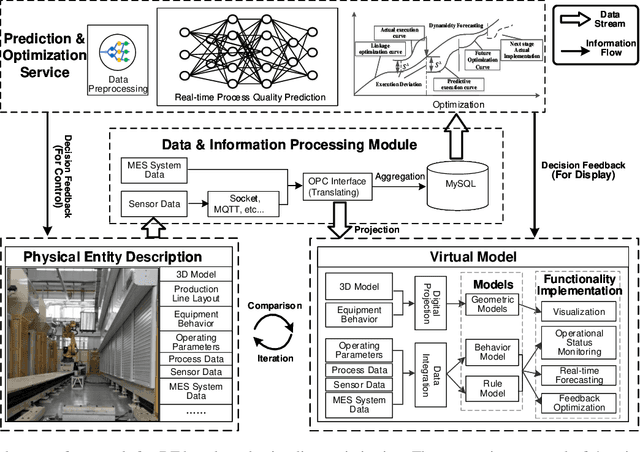
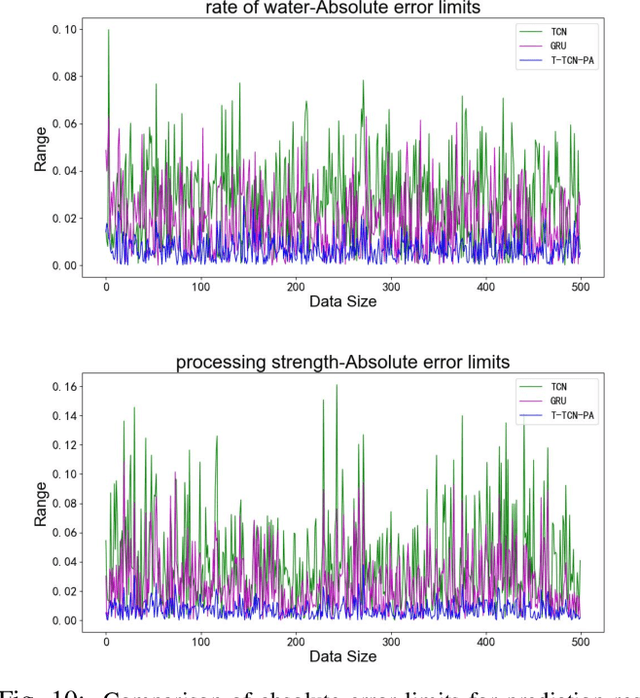
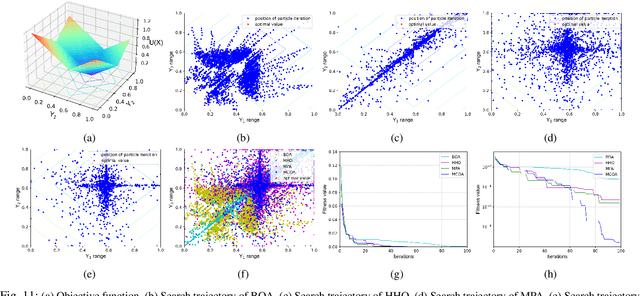
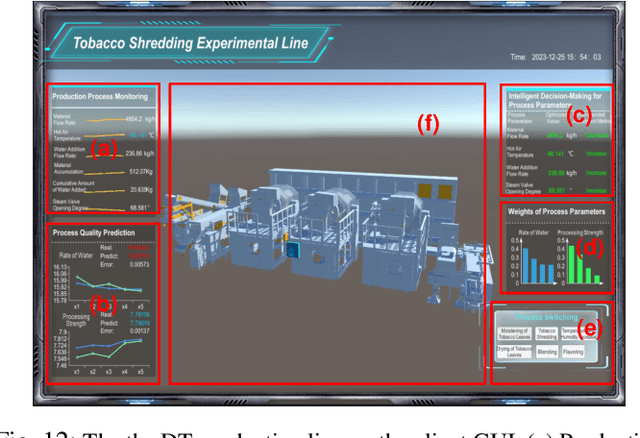
Abstract:In the process industry, optimizing production lines for long-term efficiency requires real-time monitoring and analysis of operation states to fine-tune production line parameters. However, the complexity in operational logic and the intricate coupling of production process parameters make it difficult to develop an accurate mathematical model for the entire process, thus hindering the deployment of efficient optimization mechanisms. In view of these difficulties, we propose to deploy a digital twin of the production line by digitally abstracting its physical layout and operational logic. By iteratively mapping the real-world data reflecting equipment operation status and product quality inspection in the digital twin, we adopt a quality prediction model for production process based on self-attention-enabled temporal convolutional neural networks. This model enables the data-driven state evolution of the digital twin. The digital twin takes a role of aggregating the information of actual operating conditions and the results of quality-sensitive analysis, which facilitates the optimization of process production quality with virtual-reality evolution under multi-dimensional constraints. Leveraging the digital twin model as an information-flow carrier, we extract temporal features from key process indicators and establish a production process quality prediction model based on the proposed composite neural network. Our operation experiments on a specific tobacco shredding line demonstrate that the proposed digital twin-based production process optimization method fosters seamless integration between virtual and real production lines. This integration achieves an average operating status prediction accuracy of over 98\% and near-optimal production process control.
CourseGPT-zh: an Educational Large Language Model Based on Knowledge Distillation Incorporating Prompt Optimization
May 08, 2024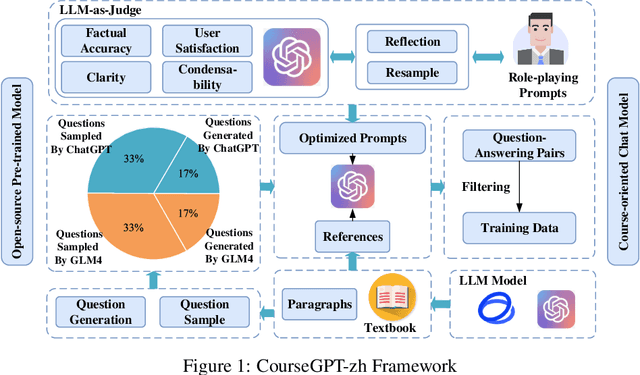

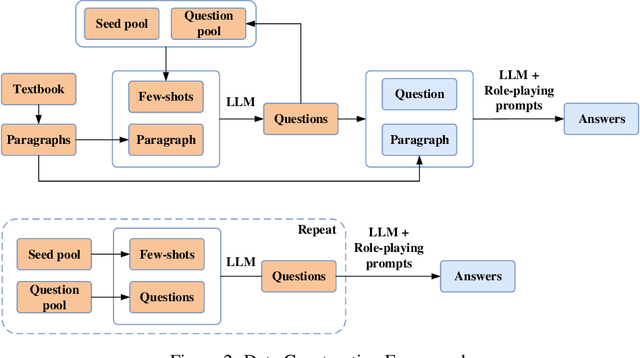

Abstract:Large language models (LLMs) have demonstrated astonishing capabilities in natural language processing (NLP) tasks, sparking interest in their application to professional domains with higher specialized requirements. However, restricted access to closed-source LLMs via APIs and the difficulty in collecting massive high-quality datasets pose obstacles to the development of large language models in education fields of various courses. Given these challenges, we propose CourseGPT-zh, a course-oriented education LLM that supports customization and low-cost deployment. To address the comprehensiveness and diversity requirements of course-specific corpora, we design a high-quality question-answering corpus distillation framework incorporating prompt optimization, which effectively mines textbook knowledge and enhances its diversity. Moreover, considering the alignment of LLM responses with user needs, a novel method for discrete prompt optimization based on LLM-as-Judge is introduced. During optimization, this framework leverages the LLM's ability to reflect on and exploit error feedback and patterns, allowing for prompts that meet user needs and preferences while saving response length. Lastly, we obtain CourseGPT-zh based on the open-source LLM using parameter-efficient fine-tuning. Experimental results show that our discrete prompt optimization framework effectively improves the response quality of ChatGPT, and CourseGPT-zh exhibits strong professional capabilities in specialized knowledge question-answering, significantly outperforming comparable open-source models.
4D-DRESS: A 4D Dataset of Real-world Human Clothing with Semantic Annotations
Apr 29, 2024Abstract:The studies of human clothing for digital avatars have predominantly relied on synthetic datasets. While easy to collect, synthetic data often fall short in realism and fail to capture authentic clothing dynamics. Addressing this gap, we introduce 4D-DRESS, the first real-world 4D dataset advancing human clothing research with its high-quality 4D textured scans and garment meshes. 4D-DRESS captures 64 outfits in 520 human motion sequences, amounting to 78k textured scans. Creating a real-world clothing dataset is challenging, particularly in annotating and segmenting the extensive and complex 4D human scans. To address this, we develop a semi-automatic 4D human parsing pipeline. We efficiently combine a human-in-the-loop process with automation to accurately label 4D scans in diverse garments and body movements. Leveraging precise annotations and high-quality garment meshes, we establish several benchmarks for clothing simulation and reconstruction. 4D-DRESS offers realistic and challenging data that complements synthetic sources, paving the way for advancements in research of lifelike human clothing. Website: https://ait.ethz.ch/4d-dress.
 Add to Chrome
Add to Chrome Add to Firefox
Add to Firefox Add to Edge
Add to Edge